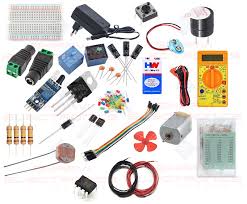In the evolving world of robotics and drone technology, choosing the right components can make all the difference in performance, durability, and control. Two essential elements that significantly impact the design and function of your projects are the robot chassis and the brushless motor for drone. These components not only lay the foundation for movement and mobility but also determine how effectively your robots or drones can perform in real-world environments.
Whether you're a hobbyist, student, or professional developer, understanding these components helps ensure your designs are both functional and future-ready.
What is a Robot Chassis?
A robot chassis is the structural frame or 5mm led base on which all components of a robot are mounted. It provides mechanical support for motors, wheels, batteries, sensors, and control boards. Available in different materials like metal, plastic, and acrylic, the chassis varies in size, shape, and configuration based on the robot’s intended use—be it a line follower, obstacle avoider, surveillance robot, or automation bot.
Key Features:
- Material Quality: Aluminum and stainless steel offer durability, while plastic and acrylic are lightweight and beginner-friendly.
- Wheel Configuration: Chassis come in 2-wheel, 4-wheel, tracked, or omnidirectional configurations.
- Mounting Slots: Pre-drilled holes or slots for easy installation of sensors, Arduino boards, and battery holders.
- Modularity: Easily customizable for upgrades and expansion.
Applications:
- DIY educational robots
- Industrial automation systems
- Robotics competitions
- Prototyping mobile AI platforms
The robot chassis acts as the skeleton of your robot, ensuring all parts are held firmly and function smoothly during operation.
What is a Brushless Motor for Drone?
A brushless motor for drone is a type of electric motor designed specifically for drone applications, offering high efficiency, reliability, and lightweight performance. Unlike brushed motors, brushless motors do not have brushes to transfer current, which reduces friction and increases the motor’s lifespan.
Key Characteristics:
- High Thrust-to-Weight Ratio: Essential for drone lift and aerial stability.
- Efficient Cooling: Built-in vents for better heat dissipation.
- KV Rating: Refers to RPM per volt; higher KV is better for racing drones, while lower KV is ideal for stable, heavy-lift drones.
- Durability: Designed to withstand vibration, impacts, and extended flights.
Common Applications:
- Quadcopter, hexacopter, and octocopter drones
- Aerial photography drones
- Agricultural spraying drones
- Racing and stunt drones
Using a brushless motor for drone ensures optimal thrust, longer battery life, and quieter operation, which are critical in both hobby and professional drone applications.
Integrating the Two in Advanced Projects
While the robot chassis is geared toward ground-based robotics, and brushless motors are for flight, combining the principles of both can lead to innovative hybrid machines. For example:
- Autonomous Delivery Bots: Ground robots with robust chassis for street navigation and drone-based delivery attachments for aerial drop-offs.
- Surveillance Systems: Combine mobile robots and aerial drones for 360-degree monitoring and security.
- Search and Rescue Robots: Use chassis for rough terrain navigation and drones for aerial scouting in inaccessible zones.
These integrations showcase how foundational components like a robot chassis and drone motor can work together for advanced, multifunctional systems.
Buying Tips
For Robot Chassis:
- Choose material based on durability and weight needs.
- Ensure it is compatible with motors, sensors, and microcontrollers you intend to use.
- Prefer modular designs for easier customization and future upgrades.
For Brushless Motors:
- Match the motor’s KV rating to your drone’s purpose—low for stability, high for speed.
- Check weight and thrust specs to ensure they support your drone’s frame and payload.
- Always pair with suitable ESCs (Electronic Speed Controllers) for optimal performance.
Conclusion
When it comes to designing innovative robotics and drones, having the right components is key. A sturdy electronic kit ensures reliable structure and mobility for ground bots, while a powerful brushless motor for drone provides the thrust and stability needed for seamless aerial performance. Together, these elements form the building blocks for countless high-performance, real-world applications in automation, surveillance, delivery, and education. Start building smarter, faster, and more efficient machines with the right tools today.

